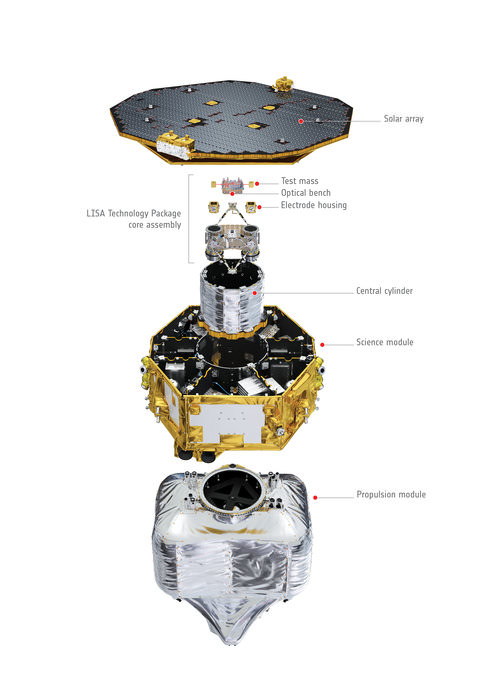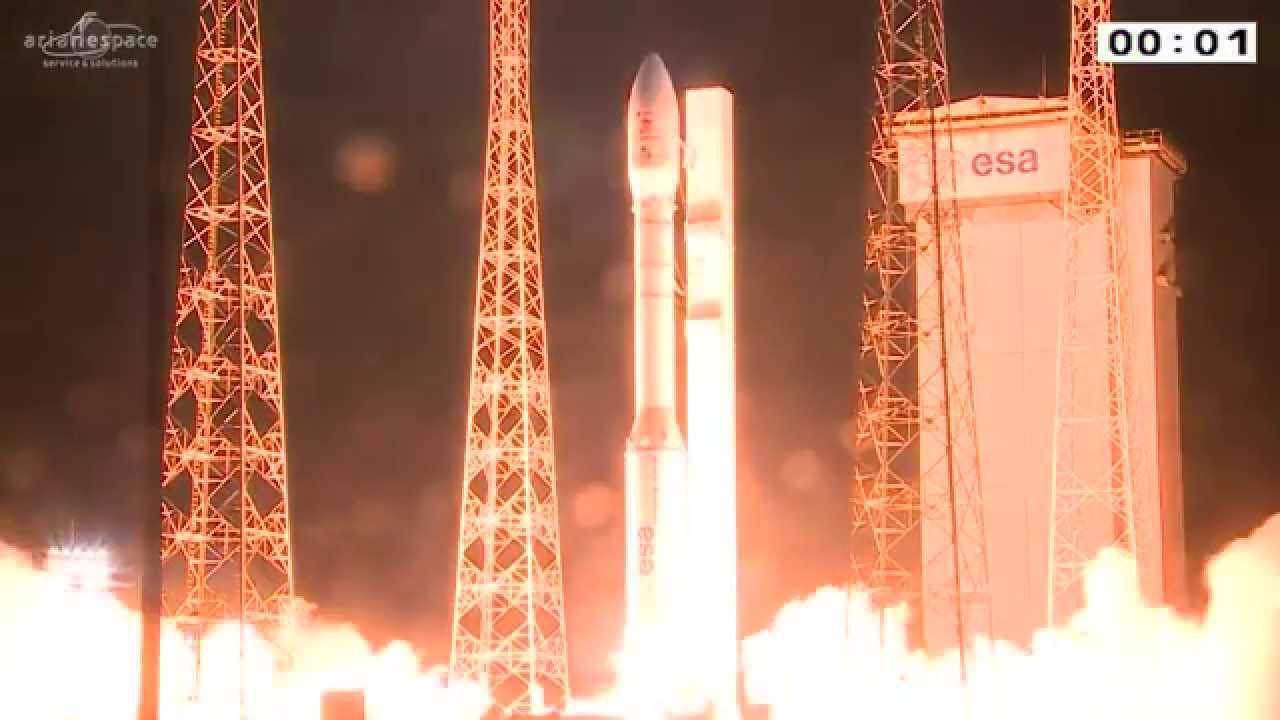The European Space Agency successfully launched the LISA Pathfinder, a spacecraft designed to demonstrate technology for observing gravitational waves in space. The launch took place at Europe’s spaceport in Kourou, French Guiana on a Vega rocket, at 4:04 GMT on December 3, (10:04 pm EST Dec 2), 2015.
Gravitational waves are ripples in the fabric of spacetime, which were predicted by Albert Einstein in his General Theory of Relativity. So far, because they are extremely tiny and incredibly faint, gravitational waves have proved to be elusive. The technology needed to detect them is highly sensitive and therefore has been difficult to conceive, plan and build.

The LISA Pathfinder mission is only testing the technology to see if it will be possible to detect the waves caused by a gravitational event such as the collision of two black holes, a supernova or a star with a wobbly spin.
Such an event should cause a minute distortion in the fabric of space, and it is predicted that these tiny changes should be detectable. However, the accuracy needed to detect any gravitational waves is extraordinary. An example of how tiny gravitational waves are: the ripples emitted by a pair of orbiting black holes would stretch a million kilometer-long ruler by less than the size of an atom.
LISA Pathfinder will use a specialized laser and interfermeter to measure the distance between two free-floating gold–platinum cubes that will be released into two separate vacuum chambers that are 38 cm apart. Between these chambers is the interferometer detectors. The cubes will be in the equivalent of freefall, and therefore be free from all external and internal forces acting on them, except for gravity. The detectors will monitor the cubes’ relative positions to high precision. These tests will lay the foundations for future gravitational wave observatories in space.
See the video below for a detailed description and visualization of how LISA Pathfinder will work:
Helping the spacecraft remain stable is the utmost importance for detecting gravitational waves, so also being tested on this mission is NASA’s Disturbance Reduction System (DRS), a thruster technology that allows the spacecraft’s position to be continuously adjusted so that the system stays centered about the test cubes. Using lasers, the position of the freely floating test masses will be measured by the interferometer instrument to an accuracy of 100,000th of the width of a human hair.
Again, LISA Pathfinder will not directly detect gravitational waves, but it will demonstrate technologies necessary to observe them. The spacecraft will now undergo a six-week commissioning period as it heads toward the Lagrange Point L1, about 930,000 miles (1.5 million kilometers) from Earth in the direction of the Sun. Then eight months of technology demonstration will take place.
If all goes well, a future full-scale spacecraft observatory could use the same kind of sensors, but they would be housed in three individual spacecraft separated by about 600,000 miles (1 million kilometers). Scientists could then measure how gravitational waves change the distance between the test masses, which would be a difference on the scale of picometers (one picometer is one trillionth of a meter).
More information: ESA LISA Pathfinder Fact Sheet, JPL,


It is not sufficient to detect a cyclic variation in gravitational intensity. If gravitational waves are real, and limited to the speed of light, there also has to be aberration. But various experiments, satellite motions, and astronomical observations have demonstrated that there is none. This implies that gravitation is instantaneous (i.e., it is “non-local”). Einstein’s Special and General Relativity theories are both “local” by design and intent. Trying to apply them to non-local phenomena is out-of-scope.
See also:
http://scripturalphysics.org/4v4a/ADVPROP.html#TheSpeedOfGravity
and
“After 11 years, physicists must rethink gravitational waves”, Graham Templeton (September 29, 2015)
What would happen if gravity has effects on itself. Would that change any of your equations or data?
@BlackWolfStanding
I am not sure what you mean by the question. However, a couple of things seem clear:
1. The METRICS of space and time (taken separately) are variable.
2. Whatever arguments apply to gravity must also be applicable (in essence) to electric and magnetic fields, as these are also non-local like gravity. (e.g., the speed of electric fields is far greater than the speed of light)
3. Nature apparently is not using space-time as many physicists are beginning to realize. The new metric will probably be space/time or time/space (i.e., “motion”; and motion may exist in an absolute form, unlike time and space; that will also introduce new math). That will change EVERYTHING, and will require many more decades of thought.
Einstein’s theories (SR and GR) addressed only half of the problem–the half that was known back in 1905. We still have a lot more work to do. See:
http://scripturalphysics.org/4v4a/ADVPROP.html#GeometrySpaceTimeMotion
It’s the force more like energy in a wave that reaches you much faster than the actual Graviton particle moves. Now the force has no Galactic speed limit, but the Graviton particles do.
Think of Gravity being water in the ocean. It’s the energy in the wave that moves. The water itself is very much slower to move.
The Gravitons obey the Galactic speed limit. The force does not have to obey any speed limit.
The difference in these speeds is what needs to be tested by LISA to prove Gravity waves exist.
GO LISA!
I am curious about something. Actually, two things. I note that the existence of gravity waves is pretty much the only prediction arising out of Einstein’s theories of relativity that has NOT been proven correct. I don’t understand relativity on a mathematical level. Is there anyone who does who can tell me whether it would be a devastating blow to relativity if gravity waves did NOT exist?
My second question is that I have never really understood how gravity waves could be detected if they DO exist. If all of spacetime would “ripple”, how could we observe it? If distances shrank or expanded, wouldn’t the methods we use to measure them shrink and expand as well? Wouldn’t the time it took for a photon of light to travel down a corridor “ripple” along with the length of the corridor? I have never understood how we could expect to measure variations in spacetime when we are embedded within it. If we could somehow become four dimensional beings and observe spacetime from outside, we could probably measure it without difficulty, but we are not. Anyhow, any input on these questions would be appreciated.
Thank you, Random. You have expressed the puzzles in my mind perfectly. It seems that all I can do is sit here twiddling my thumbs until someone who does understand the math answers the questions or acknowledges the quandary as unsolvable. Of course the “unsolvable” declaration is usually where new theories begin. So, as Aqua says: “Go LISA!”
See my other reply.